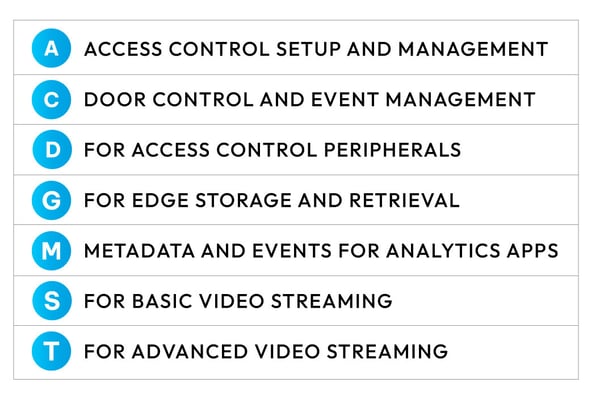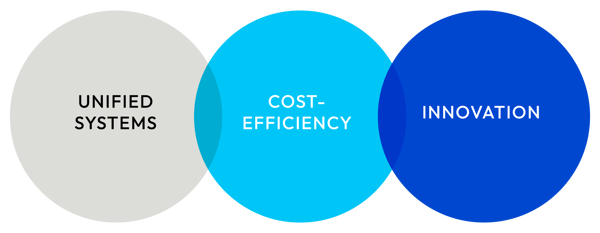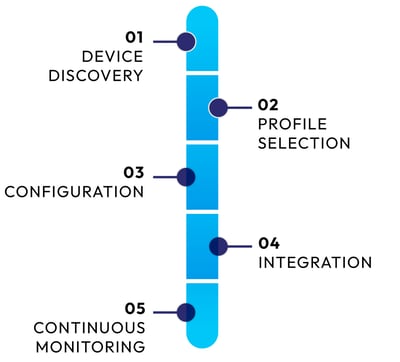
The ONVIF protocol came to solve one of the main problems in the video surveillance industry: the quest for effective integration and interoperability. As devices proliferate and the need for cohesive surveillance systems becomes paramount, ONVIF emerges as a central axis, ensuring that devices, regardless of different manufacturers, "speak a common language."
In this article, we will discuss what the ONVIF protocol is, its purpose, the nuances of its profiles, and its transformative impact in the world of video surveillance.
Table of contents
- What is the ONVIF protocol?
- What is the purpose of the ONVIF protocol?
- What are ONVIF profiles?
- Advantages and disadvantages of the ONVIF protocol
- How to integrate devices using the ONVIF protocol?
- ONVIF protocol and its impact on video surveillance
What is the ONVIF protocol?
The Open Network Video Interface Forum (ONVIF) protocol is a global and open industry forum that aims to simplify the interoperability of IP-based physical security devices from different vendors so they can be integrated into one unified surveillance system.
In simple terms, ONVIF provides a reliable way for devices from different manufacturers to work together.
The individual standardized specifications that every product has (and that are different depending on the company that produced the gadget) can be assimilated into a sort of “universal language”, this means that the ONVIF protocol acts as a bridge so that all devices can communicate efficiently.
ONVIF defines a set of protocols, specifications, and standards that govern the exchange of information between these devices, promoting a unified approach to video surveillance technology.
Founded in 2008 by Axis Communications, Bosch Security Systems, and Sony Corporation, ONVIF was born out of the need to create a universal standard for IP-based video surveillance equipment. Before its existence, devices from different manufacturers often used proprietary protocols, making it challenging for end-users to build integrated and efficient security systems. ONVIF's founders sought to establish a common language for these devices, enabling seamless communication.
ONVIF has continually evolved to keep up with technological advancements and user demands. The protocol has gone through multiple iterations, each introducing new features and improvements (such as Pan-Tilt-Zoom control, audio streaming, event handling, and access control) to better serve the security industry. Currently, ONVIF has around 500 companies as members and more than 20,000 products that are compatible with this protocol.
What is the purpose of the ONVIF protocol?
As it has been already established, ONVIF was designed for system integration between devices from different manufacturers to create customized security systems.
In other words, the primary purpose of ONVIF is to enable smooth interoperability of different physical security devices, including IP cameras, video management systems (VMS), and network video recorders (NVR).
It achieves this by providing a common language and set of protocols that all devices must adhere to. This standardization simplifies the integration of different gadgets into a unified security system, reducing costs and compatibility issues for end-users and system integrators.
Therefore, ONVIF provides an easy way to exchange video resources. This is especially useful for monitoring centers, surveillance companies, and law enforcement companies because it allows them to instantly access live and stored video or image data.
Additionally, these protocols provide extra control functions and features such as the ability to control the camera (with the pan, tilt, and zoom functions), the power to record video footage or images in the recording device as well as on an external storage unit, and it also supports live viewing and playback of record data.
To better understand how ONVIF facilitates the connectivity of physical security devices, it is useful to imagine a scenario where a user wants to integrate cameras from one manufacturer, a video management system from another, and an access control system from yet another. Without ONVIF, this integration would be challenging and costly, often requiring custom software development. ONVIF streamlines this process by ensuring that devices that adhere to its standards can work together seamlessly, reducing compatibility issues and simplifying system setup.
QUICK GUIDE TO THE ONVIF PROFILES

What are ONVIF profiles?
Even though the purpose of ONVIF is to create a standard language that allows devices from multiple manufacturers to interact, different types of devices need different protocols because they execute a specific set of functions. ONVIF profiles play a crucial role in ensuring that the compatibility between devices is tailored to specific functionalities to guarantee that the devices can work together effectively based on their intended uses.
The compatibility between devices is crucial to creating flexible security systems that will keep up with the times. You can have the option to update one or more components and choose the one that adapts to your needs or budget without having to stick to only one provider or having to redo the whole system. This generates an ample range of possibilities that allow you to create a system adapted to your needs, it is only necessary to choose a device that complies with the same profile.
Each profile has a set collection of characteristics that need to be supported by a conformant device. For example, a client that adheres to profile S can work with devices that conform to that same profile. However, it is important to note that both clients and devices can support more than one profile.
Currently, ONVIF has four profiles for access control systems (A, C, D, and M) and five that can be used to manage video systems (D, G, M, S, and T), which all include features that are considered Mandatory (M) and Conditional (C).
Although the full chart of each profile’s specifications can be consulted on ONVIF’s website, here is a small overview of what each one can do:
PROFILE A
It is mainly used for access control setup and management, which includes features such as granting and revoking credentials, assigning access rules, and creating schedules. The devices that are conformant with this profile can be used to collect information such as status and events and to set up the permissions listed above.
PROFILE C
It is intended to be used for door control and event management and thus, it allows the user to configure door access control, manage the event and the alarm, and set up the site information. It can be combined with a Profile related to video (such as Profile S) to create a more secure entry system.
PROFILE D
This profile is used to manage access control peripherals such as biometric readers, keypads, token readers, and sensors. Its main functions include the transfer of data (fingerprints, iris, facial features, door codes, and any other access request), the transfer of status data (lock status, door status temperature, and motion detection), and the ability to perform actions based in the received information such as locking and unlocking a door or displaying information.
Profile D can be used to complement Profiles A and C because it enables standardized communications in an IP-based electronic access control system. Additionally, when the access control system has a camera as the primary access device, Profile D can be paired with Profiles T or M to link the video and the access permits.
PROFILE G
Profile G was designed to configure, request, and control recording, and to receive audio and metadata stream; this allows it to work with video security systems that use IP Networks precisely to record and stream data. Some of the compliant devices to this Profile are IP network cameras and video encoders, while the compliant clients can be platforms like VMS (Video Management Software).
PROFILE M
This Profile has a variety of functions related to metadata and events for analytics applications, some of which are analytics configuration and information query for metadata, configuration and streaming of metadata, generic object classification support, metadata definition for geolocation (vehicle, license plate, human face and body), event interfaces for object counter, face and license plate recognition analytics, sending events through metadata stream, and transmission of events via metadata stream, ONVIF service or Message Queuing Telemetry Transport (MQTT).
This is the most recent Profile and it is intended to be used by devices and clients with smart analytics capabilities. It can be useful for visitor statistics, crowd control, or any other counting analytics; for access control through license plate recognition; and even for room temperature control (if a camera is programmed to detect human presence, it can trigger the thermostat).
PROFILE S
Profile S is intended for basic video streaming. The compliant devices (IP networks, cameras, and video encoders) can send video data to a compliant client via an IP network. Through the use of Video Management Software, video streaming can be remotely managed. Some other specifications are PTZ control, audio in, multicasting, and relay outputs.
PROFILE T
Similar to Profile S, Profile T is designed to be used in IP-based video systems, but this time for advanced video streaming because it supports more advanced features (it is important to note that this profile is not intended to replace Profile S, but to cover a different kind of need and even to be used in combination with said Profile).
Advantages and disadvantages of the ONVIF protocol
ADVANTAGES
Interoperability: The ONVIF protocol ensures that devices from different manufacturers can seamlessly communicate and work together in an integrated security system.
Flexibility: Users can mix and match devices from various vendors, allowing for a customized and cost-effective security solution.
Standardization: With ONVIF, there's a set standard that manufacturers adhere to, ensuring consistency and reliability across products.
Continuous Evolution: ONVIF is regularly updated to incorporate new technological advancements, ensuring that it remains relevant and effective.
Wide Adoption: With over 500 member companies and thousands of ONVIF-compliant products, users have a broad range of options to choose from.
DISADVANTAGES
Implementation Variance: While ONVIF provides a standard, the implementation can vary between manufacturers, leading to potential inconsistencies.
Complexity: For those unfamiliar with ONVIF, the initial setup and understanding of profiles can be complex.
Security Concerns: Like any other protocol, ONVIF can be vulnerable to security breaches if not properly secured.
How to integrate devices using the ONVIF protocol?
Integrating devices using the ONVIF protocol is a streamlined process. First, ensure that both the device (e.g., camera, NVR) and the client (e.g., VMS software) are ONVIF compliant. Once verified, follow these steps:
Device Discovery: Most ONVIF devices support the WS-Discovery protocol, allowing them to be automatically detected on the network.
Profile Selection: Determine the ONVIF profile that best suits the device's intended function. For instance, use Profile S for basic video streaming or Profile T for advanced streaming.
Configuration: Using the client interface, configure the device settings, such as video resolution, frame rate, and compression.
Integration: Once configured, the device can be added to the surveillance system, where it will communicate using the ONVIF protocol.
Continuous Monitoring: Regularly check for firmware updates and ensure that the device remains compliant with the latest ONVIF specifications.
ONVIF PROTOCOL’S IMPACT ON VIDEO SURVEILLANCE

ONVIF protocol and its impact on video surveillance
The introduction of the ONVIF protocol has revolutionized the video surveillance industry. Before ONVIF, integrating devices from different manufacturers was a daunting task, often requiring custom solutions and leading to increased costs. ONVIF has eliminated these barriers, promoting a more collaborative and unified approach to surveillance.
The impact of ONVIF on video surveillance is profound:
Unified Systems: Surveillance systems are more integrated, with devices from multiple manufacturers working in harmony.
Cost-Efficiency: Users can choose from a wider range of products, ensuring they get the best value for their money.
Innovation: With a standardized protocol, manufacturers can focus on innovating and adding unique features to their products.
In conclusion, the ONVIF protocol has set a new standard in video surveillance, ensuring that systems are more integrated, efficient, and adaptable to the ever-evolving technological landscape.
If you want to learn more about how a video surveillance system works, visit our article here. And learn everything about video analytics in our full guide here.
